
Transcription
THE ROLE OF COLOURIN FILMS: INFLUENCINGTHE AUDIENCE'S MOODDaniel James Berens6596 WordsSubmitted in part fulfilment of the requirements ofthe BA (Hons) Film & Moving Image ProductionLeeds Metropolitan University
ContentsList of Illustrations (Page 2)Acknowledgements (Page 3)Abstract (Page 4)Introduction (Page 5)Chapter One - The Science of Colour:How universal is the perception of colour? (Page 7)Chapter Two - 20th Century: Vittorio Storaro’suse of colour in celluloid films (Page 17)Chapter Three - 21st Century: The varied useof colour in digital films (Page 31)Conclusion (Page 43)Bibliography (Page 45)Page 1 of 50
IllustrationsFigure 1 - Page 9 - ‘Colours selects as experimental stimuli’ - Berens (2012)Figure 2 – Page 10 - University of California, Riverside (n.d)Figure 3- Page 18 - Taken by Daniel Berens at Camerimage 2013Figure 4- Page 19 - Snow White and the Seven Dwarfs (1937)Figure 5- Page 21 – Image from DVD - Dick Tracy (1990)Figure 6- Page 22 - Image from DVD - Dick Tracy (1990)Figure 7- Page 22 - Image from DVD - Dick Tracy (1990)Figure 8- Page 23 - Image from DVD - Dick Tracy (1990)Figure 9- Page 24 - Image from DVD - Dick Tracy (1990)Figure 10- Page 25 - Image from DVD - Dick Tracy (1990)Figure 11- Page 27 - Image from DVD - Apocalypse Now Redux (2001)Figure 12- Page 28 - Image from DVD - Apocalypse Now Redux (2001)Figure 13- Page 29 - Image from DVD - The Last Emperor (1987)Figure 14- Page 32 - Image from DVD - Sin City (2005)Figure 15- Page 33 - Image from DVD - Sin City (2005)Figure 16- Page 34 - Image from DVD - Sin City (2005)Figure 17- Page 35 - Image from DVD - Sin City (2005)Figure 18- Page 36 - Image from DVD - Sin City (2005)Figure 19- Page 37 - Image from DVD - Amélie (2001)Figure 20- Page 38 - Image from DVD - Amélie (2001)Figure 21- Page 40 – Image from DVD - Amélie (2001)Figure 22- Page 41 - Image from DVD - Slumdog Millionaire (2008)Page 2 of 50
AcknowledgementsSpecial thanks to my brother, Sam Berens, who gave me an extraordinary insightinto neuroscience which inspired me to research this topic. Thank you also toCatherine Connolly and Romany Dale for their advice and for proofreading mydissertation. Lastly, thanks to Mark Carey who has supervised me on this study.Page 3 of 50
The Role of Colour in Films:Influencing the Audience'sMoodAbstractThis research explores the role colour plays in influencing an audience’s mood. Thestudy reveals that the perception of colour, colour combinations and colour memoryare not universal but is affected by the language we speak, our culture,environmental factors and even our gender. Colour perception is even affected bysound as well as other colours. Research also shows that colour directly affects ouremotional state, influencing behaviour, sleeping patterns, aggression and howenergised we feel. Bright, saturated and long wavelengths, are more stimulating andarousing than less saturated, darker and shorter wavelengths of light. The studylooks at the symbolism of colour in films and has found that colour can mean manyseemingly contradictory concepts even within the same film, showing that context ofcolour plays a major role in its meaning. Ultimately cinematographers, whetherrealising it or not, make use of neuroscience and symbolism to affect an audience.Page 4 of 50
IntroductionThis study looks at one of the most powerful, but least understood and exploredelements of cinematography: colour. From Alfred Hitchcock’s dramatic black andwhite film, Psycho (1960), to Vittorio Storaro’s symbolic colours in Apocalypse Now(1979), colour has the ability to affect us either consciously or unconsciously. Bygaining a scientific insight into the way colour affects people neurologically andphysiologically, the aim of this study is to gain a greater understanding of the ways inwhich colour influences people’s moods. Then, by taking this understanding andanalysing films, the intention is to show how some of the best cinematographers inthe world use colour as an important device to influence people. Also, by givingcinematographers crucial knowledge to make their unconscious creative decisionsconscious, the study hopes to empower them in creating more meaningful and moreemotionally powerful films.In cinematography, there has been little research in this field and colour may bepoorly attended given to how ubiquitous it is (Peacock, 2010). This study reviews thescience of colour and the use of it in cinema, identifying Vittorio Storaro as aninfluential colourist. Like Hirsch (2011), Malpas (2007), Coates (2010), Brown, Streetand Watkins (2013), this study will take a symbolic, psychological and aestheticapproach to the analysis of colour in films. Ultimately this research considers howscience can give new creative tools to artists in a digital age, set against the historyof colour within analogue film techniques.Unlike other studies, this study acknowledges the difference between light(electromagnetic radiation which is not directly visible) and colour (a perceptualPage 5 of 50
experience constructed by the brain). As such, black and white will be consideredcolours in this study, since they are perceived in the brain like any other colour.The Importance of ColourIn the article Colour, Form, and Movement Are Not Perceived Simultaneously,Viviani and Aymoz (2001) explain that colour and form are almost experiencedsimultaneously while movement is delayed by about 50 milliseconds. Since weperceive colour before movement and since cinema is essentially moving colour,Brown (2013, p.209) argues that colour is a spectacle and just as important asnarrative which “has at its core in-frame movement”.Colour is known to influence people in ways that are not immediately apparent andso the use of it to affect an audience has been exploited in films and many domainsand colour science continues to form new discoveries. Recently it was shown thatcertain colours in the right context can enhance memory (Kuhbandner and Pekrun,2013). It has even been used by high street and online shops to increase sales bystimulating positive moods through longer wavelengths with faster background music(Cheng et al., 2009; Aslam, 2006).Page 6 of 50
Chapter OneThe Science of Colour:How universal is the perception of colour?The fusion of art and scienceThe approach adopted here is to gain a scientific grounding, specifically in the fieldof neuroscience and physiology, to understand how colour affects people and tounderstand how universal colour perception is. Abramov et al. (2012) suggest thatmen and women do not see the same colours; males need longer wavelengths thanfemales to experience the same hue: “females are better at discriminating amongcolours while males excel at tracking fast-moving objects and discerning detail froma distance” (Owen, 2012, p.1). Lee and Joohyeon (2005) highlight the twocategories for the perception of colour: the biological response and colour memories(the learned and cultural response). This chapter will seek to unpack theseresponses in light of the scientific evidence. Neuroscientists from The SussexColour Group (a leading colour science research group) were interviewed to heartheir results and explanations on how colour can affect people’s psychology.Finally this chapter will build upon these fundamentals by overviewing the science inthe context of cinema. The aim is to show how universal the perception of colour isand how it is influenced by many factors including language, colour memories, colourconsistency, colour combinations and even by the cinema experience itself.Neuroscientist Sam Berens (from the University of Sussex) explains that we seecolour through a filter of language and memory, making everyone’s perceptiondifferent. Our language determines how we categorise colours into groups and thisPage 7 of 50
embedded linguistic grouping system influences how we see and think about colour.Berens also highlights that memories may be associated with certain colours and socan be stimulated by colour perception. This section will delve deeper to understandhow significant this is and why different factors affect the perception of colour makingno two people see colours in the same way. In light of this science the study will askwhat this means for cinematographers and image makers who may need toinfluence the emotions of a wide audience rather than any particular culture.Categorical Perception in Adults:The effect language has on the experience of colourThe right hemisphere of the brain is implicated in non-categorical chromaticprocessing, thereby giving rise to metric colour sensitivity. This means that the rightside of the brain does not identify colours within any sort of linguistic category suchas blue or green. In contrast, the left hemisphere language regions are associatedwith the categorical perception of colour. This lets us see colours within our ownlinguistic categories allowing us to group colours and quickly differentiate them fromother categories, having huge implications on the way we see (Regier and Kay,2009; Bird et al. 2014; Franklin et al., 2008). As such, colours from differentcategories seem very different from ‘within category’ colours, even when thesecolours are equally spaced along the spectrum. In Figure 1, even though these fourcolours are equally spaced by a hue angle of 26.37 degrees, G1 seems greater indifference than from the other colours (B1, B2 and B3) thanks to the linguisticdistinction between green and blue.Page 8 of 50
Figure 1. Sam Berens (2012)‘The Whorfian hypothesis’, proposed by Benjamin Lee Whorf (see Regier and Kay,2009) attempts to account for this by suggesting that colour categories, which areentirely constructed by language, warp visual input in line with learned colour names.As such, the hypothesis suggests that “languages with different naming schemesshould produce different perceptual colour spaces” (Berens, 2012, p2); therefore“colour naming is determined by culture” (Pos, 2010, p.40) meaning that theperception of colour is not universal. From language to language, the position of thecolour categories varies; thus the point at which one colour stops and another colourbegins is always different. An extreme example can be seen in Papua New Guineawhere native speakers of the Berinmo language regard blue and green as the samesince their language does not have separate words to describe them. As a resultthey do not differentiate between them, however they have other unique colourcategories which English and many other languages do not have (BBC, 1999; Regierand Kay, 2009).Page 9 of 50
This Whorfian hypothesis contrasts with the ‘Universalist’ theory which argues thatcolour categories are biologically hardwired meaning that colour perception isuniversal (see Regier and Kay, 2009). As consensus has shifted back and forthbetween the two hypotheses, it has recently been shown that both hypotheses arepartly correct. Regier and Kay (2009, p.1) explain this by suggesting that “half of ourperceptual world might be viewed through the lens of our native language, and halfviewed [with less of] a linguistic filter”. Our vision is made up of the left and rightvisual fields which are processed by the right and left hemispheres respectively (socalled contra-lateral representation). In other words, the left visual field (LVF) isprocessed by the right hemisphere of the brain (where non-categorical chromaticprocessing occurs) and the right visual field (RVF) is processed by the left side of thebrain, which is also responsible for language and thus colour categorisation (Regierand Kay, 2009; Bird et al., 2014; Berens, 2012). This means that we process colourdifferently depending whether what we see is on our left or right side of our field ofview (see Figure 2). This has implications for cinematographers who mustunderstand how differently their colours might be perceived around the world. If, forexample, cinematographers choose one palette of colours, such as blues, they mustunderstand that it may not be seen as one category of blues in a foreign language.Instead it could be perceived as two groups ofcolours or vice versa.Figure 2. University of California, Riverside (n.d)Page 10 of 50
Colour and EmotionColour directly affects people’s emotional state (Conway, 2012) and many scientistshave studied the effects of different lighting conditions on people’s feelings (e.g.Radulescu et al., 2012; and Küller, 1986). Küller (1986) explains that in addition toconverting light into electrical impulses which affect various visual areas, suchimpulses travel to hormone and nerve centres in the brain indirectly affectingpeople’s hormone balance and psychological state. Such an example can be seen inthe pineal gland in the brain which controls a person’s diurnality (sleeping patterns)based on how the gland reacts to light and darkness.Küller (1986) also suggests that:Glaring light, strong colours, and contrasts might produce an increase in[reticular] activation [thereby causing psychological arousal and alertness].Long-wave light (red) might be more activating than middle and short-wave(green, blue). When it comes down to flicker, even if it cannot be seen by thenaked eye, it might lead to excessive activation (p.3).Valdez and Mehrabian (1994) note that shorter wavelength colours (blue and green)are less arousing than longer wavelengths (red and yellow) and that: “arousal is apositive correlate of color saturation and brightness” (ibid, p.396). Cheng et al.(2009) support this when saying “warm colours, especially red, are physically andemotionally arousing, exciting and distracting; whereas cool colours, especially, blueare relaxing, peaceful and calm” (p.327). Interestingly, to reduce suicide-railwaydisruptions, Japanese rail companies have incorporated blue lighting on railwayplatforms which appears to have contributed to a sharp fall in people jumping in frontof trains (Matsubayashi, Sawada and Ueda, 2012). This may be due to the fact thatblue is more pleasurable and less stimulating/arousing than warmer lighting (Valdezand Mehrabian, 1994), which might otherwise help give energy that would drive aPage 11 of 50
person to carry out their suicide plan. Blue lighting on streets has also been shown toreduce crime (Grohol, 2008; Chicago Tribune, 2008). This might be due to the factthat blue is a calming, tender and soothing colour which also universally representspolice presence and therefore security (ibid; Valdez and Mehrabian, 1994). At theopposite end of the spectrum, Attrill et al. (2008) have shown that red shirts havehelped English footballers win games substantially more often. Guéguen and Jacob(2012) show in restaurants, that male customers give higher tips to waitresseswearing red clothes, since red makes them seem more attractive. Bagchi andCheema (2013) highlight that scientific research shows that red induces arousalwhich may lead to aggression. Their results show that red as a background colourincreases more aggressive steps in an auction as opposed to blue which decreasessteps even more rapidly than grey. Bagchi and Cheema also show that reddecreases offers in negotiations while blue increases them. This could be very usefulto cinematographers who need to know how colours affect people so that they canuse this in cinema. It might seem obvious that red increases anger and stimulationwhile blue makes people calmer and more relaxed, but by knowing this science, itcan help cinematographers understand, change and defend their creative decisionsto create more powerful films.As we have seen, colour is partly seen universally and partly influenced by language,so this raises the question of just how universal the human emotional reaction tocolour is. Bellantoni (2005) conducted a small experiment in which he asked art andfilm students, from across the world, to paint pictures of emotions. The results can beseen as surprisingly similar; light, pale, blue and peach colours were used fortranquillity while dark red and contrasting colours were used for rage. Scientificresearch supports this: in one study “every adult assigned yellow to happiness, bluePage 12 of 50
to sadness and red to anger” (BBC, 2011). Businesses already capitalize on theneurological science of universal colour perception in marketing. A number of brandand product marketing professionals explain the workings such as in Aslam’s (2006)article, Are You Selling the Right Colour? and Cheng et al.’s (2009) paper, The Effectof Online Store Atmosphere on Consumer's Emotional Responses.Many studies on colour have shown that in industrialised cultures people generallyprefer blue colours to yellow colours (Valdez and Mehrabian, 1994; Ou et al, 2003;Taylor, Clifford and Franklin, 2012). It has been shown that people like or dislikecolours to the degree which they are associated with objects that are liked or disliked(ibid). For example, Taylor, Clifford and Franklin (2012) explain that blue is likedbecause it is considered good for survival since it is associated with pure water,while green-yellow is the opposite since it might be associated with faeces and rottenfood. However, by comparing British adult colour preferences to those of a nonindustrialized culture of the Himba people, Taylor, Clifford and Franklin (2012) haveshown that colour preferences are not simply universal or genetically driven aspreviously thought, but instead are influenced by culture, social or environmentalforces. This difference might be due to the fact that the Himba people aresurrounded by natural materials while industrialised cultures are dominated byartificial, high colour saturated objects (ibid). There has also been some research onthe effects of colour combinations. In general, people prefer disharmonious colourcombinations to harmonious colour combinations; however they are more likely todislike harmonious combinations than like disharmonious combinations (Ou et al,2003, p.389). By understanding people’s colour preferences, it will givePage 13 of 50
cinematographers a better indication of how different cultures will view coloursaesthetically, which ultimately influences their enjoyment of a picture.The Difference between Colour Perception and MemoryHenry, Cheung and Westland (2008) explain that we have three types of colourmemory: two types of long-term recall and one type of short-term storage. “Longterm colour memory seems to have a cognitive component in terms of users’preferred colours and is also influenced by an individual’s precision of matching”(ibid, p.1). We share surprisingly precise, however not accurate, expectations ofwhat commonly perceived colours should look like (Hurkman, 2011). Hurkman(2011) points out that memory colours are not the same colours we see in reality andare more saturated than “actual measured saturation of the original subjects”(p.293). This supports Henry, Cheung and Westland’s (2008) findings who have alsoshown that colours remembered are “much more saturated” (p.1) and that colourmemory also deviates in “lightness and brightness attributes while hue also deviatesbut in a less predictable manner” (ibid). In 1946, in the paper Investigation of HumanColour Memory, Bodrogi and Tarczali presented their results:Brick appeared to be remembered as redder than the object, sand as moreyellow, grass as greener, dry grass as more yellow, and pine trees asgreener. Lightness of the memory colours, in all cases except brick, ranhigher than in the object color perceptions (Cited in Hurkman, 2011, p.293).This raises the question; if what we expect to see is different from reality, shouldcinematographers and colourists aim to reproduce these memory colours? In thepaper Does an Expert Use Memory Colors to Adjust Images? Boust et al. (2004)have shown that viewers prefer images that use memory colours over those that usePage 14 of 50
original colours. Furthermore Boust et al. (2004) also concluded from their resultsthat image-making professionals do change colours to match their own memorycolours, particularly for natural materials like skin, grass and the sky.The Interaction between Colour and SoundIn the book Perception and Imaging, Zakia (2007, pp.142-143) explains that it is wellknown that sound influences colour perception due to a neurological phenomenonknown as synaesthesia; literally meaning a mixing of the senses, such thatsensations in one sensory modality can cause conscious perceptions in a completelydifferent sensory modality. However Synaesthesia is a rare neurological conditionpresent within approximately 4% of the population (Baron-Cohen, 2013 and Garfield,2006), so how can colour influence sound for the rest of us? In an interview withSam Berens, he explains that one of the more common forms of synaesthesia istone-colour synaesthesia, where listening to sounds results in a "hallucinated"experience of colour. Interestingly, synaesthetes with these experiences tend toagree on which sounds map onto which particular colours, more than would beexpected by chance, suggesting there may be a hard-wired biological mappingbetween colour and sound (Ward, 2006). Furthermore, while such synaestheticexperiences exist for a select few, recent research has shown that when nonsynaesthetes are asked to select the most appropriate colour for a particular tone,they also agree on the mappings more than would be expected by chance (ibid).Specifically, high tones seem to be associated with bright yellows and low tones withdark blues (BBC, 2011). Professor Jamie Ward (psychologist at the University ofSussex) has shown that we are all partly synaesthetic (Garfield, 2006). In anexperiment involving 200 people, Ward asked them to choose which animation bettermatched the music. One colour animation was made by non-synaesthetes toPage 15 of 50
accompany the music and another colour animation was designed by synaesthetes.The subjects overwhelmingly chose the synaesthetic-made colours, suggesting thateven though we do not know it, we are all synaesthetic to some extent (ibid). In lightof the evidence it can be speculated that to produce a more harmonious scene, thecolours in the composition should match the equivalent sound colours. Conversely,when needing to produce a more uncomfortable possibly dramatic scene, thereshould be colour-tone dissonance. Since this science is not widely understood, itmay explain why it might not be fully exploited in cinema. If this was used in cinemait might make films more emotionally powerful, giving new techniques to affect anaudience: colour-tone dissonance may induce anxiety while colour-tone harmonymight reduce anxiety. As this science becomes more widely understood,cinematographers and sound designers/composers may come to collaborate moreclosely as they become aware that their own choices affect the perception of eachother’s compositions.Page 16 of 50
Chapter TwoVittorio Storaro, winner of three Oscars and one BAFTA for best cinematography(Storaro, 2013), is known for his opinion on the importance of colour as aninstrument in cinema. In his book Storaro: Writing with Light: Colors: 2 (2004) heexplains the symbolism of colour, not just in his own films but in the wide scope ofart. For Storaro colour can represent numerous things: for example white representsthe body, red – vital energy, orange – growth, love and family, green – nature andlife. (Storaro, 2004).The work of Storaro will be explored to see how colour symbolisation is used in threeof his films originally made between 1979 and 1990: Dick Tracy (1990), The LastEmperor (1987) and Apocalypse Now Redux (2001 version). The importance ofcolour will be discussed, the choices and use of it, and the significance it has in hisfilms. The aim of this chapter is to conclude the effectiveness and use of colour inStoraro’s celluloid films.Page 17 of 50
The Importance of Colour for StoraroStoraro explains how influential colour can be:Since the beginning of time, the body reacts one way: you expose the body tolight (or yellow), you get activity, you need to work. Each time you expose thebody to darkness (or blue), you need to rest. Since the beginning, the humanbody has made this journey into night and day. Today scientists have proventhat your body changes in the presence of a particular color. Your body reactsdifferently to different colors. You become more active or more relaxed ormore depressed. Even your blood pressure may change (Schaefer andSalvato, 2013, p.225).As discussed, red affects people in many ways by making them more stimulated. Inan interview at Camerimage 2013, (Figure 3), Storaro supports this when explaininghow even wearing red influences his mood of that day:Why am I wearing this colour today? I feel that Ineed some kind of energy to speak with you guys.Normally without thinking I select the colour frommy dresser according to my mood of that day,according to that scene I'm going to film. Believeme sometimes I don't do it in a conscious way; I doit in an unconscious way because those energies,those vibrations, help for that specific moment inmy life. It’s called chromatherapy.Figure 3. At Camerimage 2013Storaro’s learning and inspiration came from watching the early Walt Disneycartoons which he regards as one of the best uses of colour in cinema: “every singlecolour was [carefully] selected by the technician, the creative people of Disney”, theyhad to know colour theory, “because they have to speak with the very simple mind of[the child].” Storaro points to an example of the red apple in the film, Snow WhitePage 18 of 50
(Figure 4). “Why the apple is red? It could be green.” Storaro explains that it isbecause of the symbolism and the meaning of red.Figure 4. Snow White and the Seven Dwarfs (1937)After being influenced by Disney, Storaro later undertook research into colour anddiscovered: “in psychoanalysis, every color represents something specific in anemotional sense. It’s not something that I made up; it’s something that scientists andresearchers have studied” (Schaefer and Salvato, 2013, p.225).Storaro explains that his approach to designing the colour palette in a film comesafter he reads the script, discusses the direction of the film with the director and to“find what is the main idea and how it can be represented in a symbolic, emotional,psychological, realistic and physical way” (Schaefer and Salvato, 2013, p.222).Sometimes Storaro’s choice of colour palette is unconscious:Sometimes you really can’t explain it. It arrives to you by intuition and you do it[ ] some time later you may discover why. Honestly, I didn’t know why I didall Paris in blue tones for The Conformist and then two years later I did it inorange for Last Tango in Paris. At the time, it was the feeling I got throughthese kind of wavelengths and through these kinds of color (Schaefer andSalvato, 2013, pp.227-228).Page 19 of 50
At Camerimage 2013, Storaro stresses the importance of learning about colour whenwe make films: “we should be more aware about the meaning. What it means to usethat colour, [or] the red colour, [or] that blue colour, [or] the yellow colour next to acomplementary one [and so on].” When we know what colour means only then canwe “be strong to defend our images” and create more expressive films, explainsStoraro.Dick TracySince Dick Tracy originally evolved from a comic strip, the film’s visual style staysfaithful to the original text, keeping the franchise identifiable as a visual fingerprint.Since the genre is a film noir comic book movie, it has allowed Storaro to useunrealistic (unmotivated) and very pure (saturated and therefore unnatural) colourssince the narrative itself is the opposite of realism. This has freed Storaro to use awide range of colours, carefully chosen in a similar way to the artists in early Disneyfilms.Page 20 of 50
Yellow obsessionFigure 5. Dick Tracy (1990)Yellow is a contradictory colour that is disliked and increases anxiety; however it isassociated with happiness, wealth and knowledge/wisdom (Storaro, 2004;Bellantoni, 2005): “people in the doldrums believe yellow is light and sunny and willcheer them up. But yellow creates anxiety and makes you more stressed out Inyellow’s presence, you’ll be more apt to lose your temper” (cited in Bellantoni, 2005,p.79).Bellantoni (2005) identifies yellow as a signal in films which highlights obsessionsince it is a colour which increases anxiety and lingers in our minds the most. Yellowis used in Dick Tracy’s obsessive yellow dress code (Figure 5): his yellow jacket andhat identify him as an obsessive person who always thinks about his duty first.Therefore he prioritises his job over his personal life, triggering his relationshipproblems.Page 21 of 50
Red has multiple meaningsFigure 6. Dick Tracy (1990)Red is used to scream murder to the audience in Figure 6, where a police officer isshot before he can report suspicious activities inside a warehouse. Inside thewarehouse (Figure 7) red is also used in the surrounding mise-en-scène, showingthe murder of Lips by Big Boy’s men, who force him to sign the deed to his propertyand later kill him.Figure 7. Dick Tracy (1990)Page 22 of 50
Figure 8. Dick Tracy (1990)Red is not just used to warn us of murder. In Figure 8, red lighting is used toaccentuate the anger, frustration and tiredness of the dancers after being beratedand mistreated all night by Big Boy. As discussed in chapter one, red helps toincrease the audience’s anger, which in this scene makes us empathise with thedancers.Page 23 of 50
Figure 9. Dick Tracy (1990)Lastly red is used to show the close relationship Dick Tracy has with the orphan andhis love for Tess (Figure 9). Red clothes are worn and also used in the backgroundsets, such as in the dinner scenes.PurpleIn the book, If It’s Purple, Someone’s Gonna Die, Bellantoni (2005) points to manyexamples in films where purple is used to foreshadow death. It is not just used toliterally indicate death,
elements of cinematography: colour. From Alfred Hitchcock's dramatic black and white film, Psycho (1960), to Vittorio Storaro's symbolic colours in Apocalypse Now (1979), colour has the ability to affect us either consciously or unconsciously. By gaining a scientific insight into the way colour affects people neurologically and










